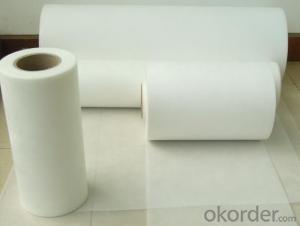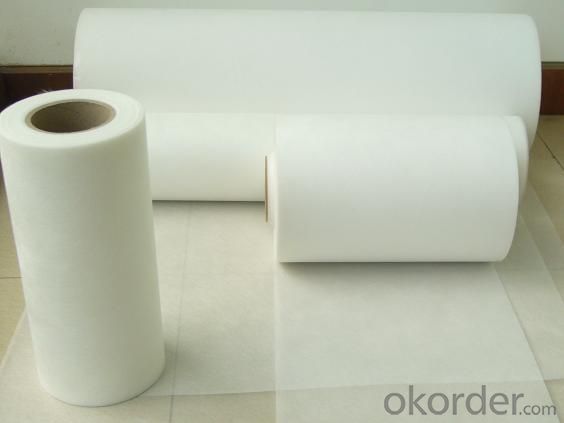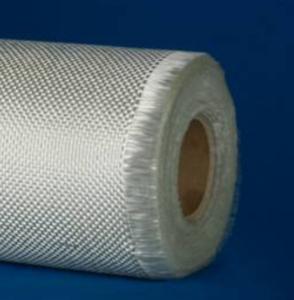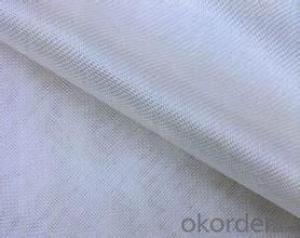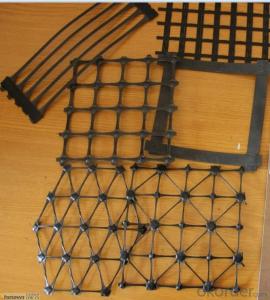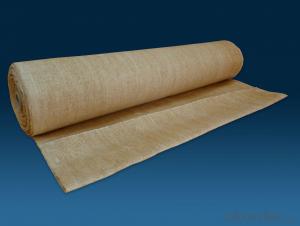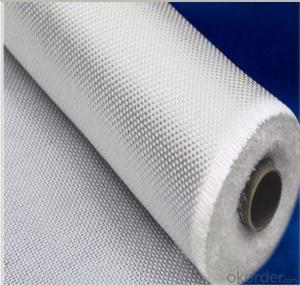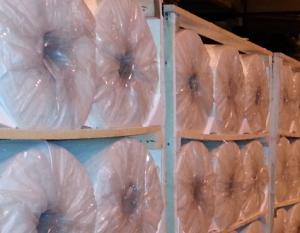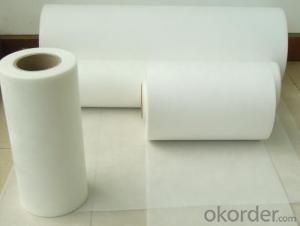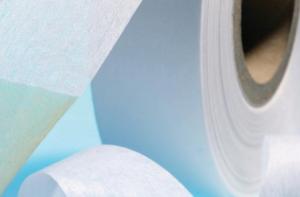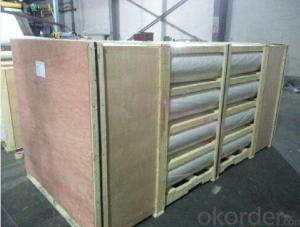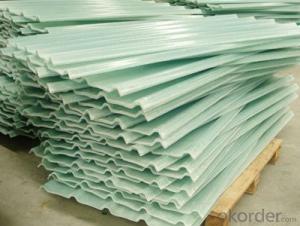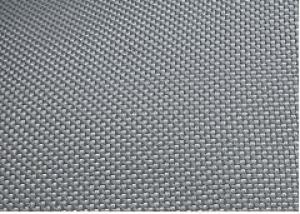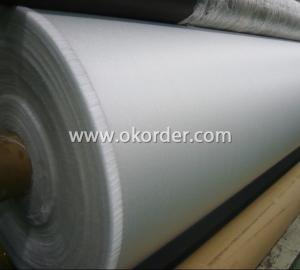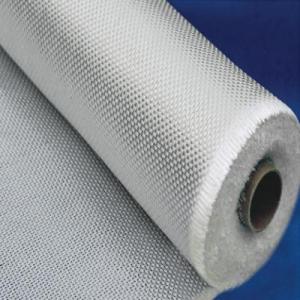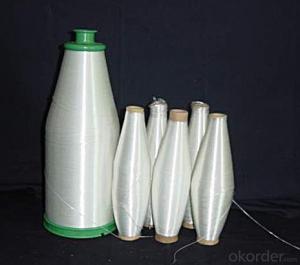Fiberglass Fabrics Surfacing Tissue Mat
- Loading Port:
- China Main Port
- Payment Terms:
- TT or LC
- Min Order Qty:
- 72000 m²
- Supply Capability:
- 1440000M2 Per Month m²/month
OKorder Service Pledge
OKorder Financial Service
You Might Also Like
1.Brief Introduction1.Brief Introduction
Surfacing Tissue mainly used in the surface layers of FRP products. It features even Fiber distribution, soft feel, level and smooth fiber surface, less glue content, quick resin soak and good pattern fitness. It can improve the product surface property on corrosion resistance, compressive strength, seepage resistance, and longer service life. It is also suitable for spraying; pattern pressing and other FRP pattern technology.
2.Characteristics
Fast breakdown in styrene
Fiber dispersed evenly
Low binder content
Superior acid corrosion resistance
3.Specifications
Item | Unit | Specification |
Area Weight | g/m2 | 30+/-3 |
Binder Content | % | 6-9 |
Tensile Strength MD | N/125px | ≥35 |
Soaking time | S | ≤10 |
Moisture content | % | ≤0.5 |
Width length
| mm
| 1270
|
Roll Diameter
| m | 300
|
Paper Core Internal Dia | mm | 76 |
Special specification can be produce according to customer requirements.
4.FAQ
a.Pacage
Each Surface Tissue is wound onto a paper tube which has an inside diameter of 76mm and the mat roll has a diameter of 330mm. The mat roll is wrapped up with plastic film,and then packed in a cardboard box or wrapped up with kraft paper. The rolls can be vertically or horizontally placed. For transportation, the rolls can be loaded into a cantainer directly or on pallets.
b.Product storage:
Unless otherwise specified, Chopped Strand Mat should be stored in a dry, cool and rain-proof area. It is recommended that the room temperature and humidity should be always maintained at 15℃~35℃ and 50%~75% respectively.
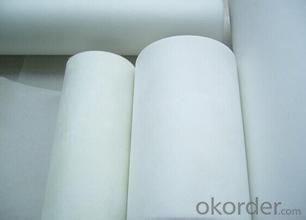
- Q: How is fiberglass fabric used in the packaging industry?
- Fiberglass fabric is widely used in the packaging industry for various purposes. It is known for its strength, durability, and heat resistance properties, making it an ideal material for packaging applications. One of the primary uses of fiberglass fabric in the packaging industry is as a reinforcement material. It is often used to reinforce cardboard boxes, crates, and other packaging materials to increase their load-bearing capacity. By adding a layer of fiberglass fabric, the packaging becomes more robust and can withstand heavier loads without getting damaged. Fiberglass fabric is also commonly used as a protective lining or wrapping material. It can be used to line the inside of packaging containers, such as drums or barrels, to provide an additional layer of protection. This helps to prevent any leakage or damage to the contents during transportation or storage. Furthermore, fiberglass fabric is utilized for insulation purposes in the packaging industry. It is commonly used to insulate packaging materials that need to maintain a specific temperature, such as cold chain packaging for perishable goods or thermal insulation for sensitive electronics. The heat resistance property of fiberglass fabric helps in maintaining the desired temperature inside the packaging, ensuring the safety and quality of the products. Additionally, fiberglass fabric is also used as a barrier material in the packaging industry. It can be used to create a moisture or vapor barrier by laminating it with other materials. This helps to protect the packaged goods from moisture, humidity, or other external factors that could potentially damage them. In summary, fiberglass fabric is extensively used in the packaging industry for reinforcement, protective lining, insulation, and barrier purposes. Its strength, durability, heat resistance, and insulating properties make it an excellent choice for various packaging applications, ensuring the safety and integrity of the packaged goods.
- Q: Is fiberglass fabric suitable for use in medical dressings?
- Yes, fiberglass fabric is suitable for use in medical dressings. Fiberglass fabric has several properties that make it ideal for this application. Firstly, it is highly durable and strong, providing excellent support and protection to the wound or injury. It is also resistant to tears and punctures, ensuring that the dressing remains intact even during movement. Additionally, fiberglass fabric is lightweight and breathable, allowing air and moisture to pass through, which promotes healing and prevents infections. Moreover, it is non-absorbent, meaning that it does not retain moisture, preventing the dressing from becoming soggy or uncomfortable. Fiberglass fabric is also hypoallergenic, minimizing the risk of allergic reactions in patients with sensitive skin. Overall, these qualities make fiberglass fabric a suitable choice for medical dressings as it provides the necessary protection and support while maintaining comfort and promoting healing.
- Q: Are fiberglass fabrics suitable for use in the mining industry?
- Yes, fiberglass fabrics are suitable for use in the mining industry. Fiberglass fabrics are known for their high strength and durability, making them ideal for use in demanding applications such as mining. They have excellent resistance to chemicals, abrasion, and high temperatures, which are common in mining operations. Fiberglass fabrics are also lightweight, making them easier to handle and install in mining equipment and structures. They have a low thermal conductivity, which helps to reduce heat transfer in mining environments, protecting workers and equipment from excessive heat. Furthermore, fiberglass fabrics have good electrical insulation properties, which is crucial in mining operations where there is a risk of electrical hazards. They are also non-combustible, providing an added level of safety in potentially hazardous mining environments. Additionally, fiberglass fabrics can be manufactured in various forms such as woven, non-woven, or as composite materials with other fibers or resins. This versatility allows for customization to meet specific mining industry requirements, such as flame resistance, chemical resistance, or increased strength. In summary, fiberglass fabrics are highly suitable for use in the mining industry due to their strength, durability, resistance to chemicals and high temperatures, lightweight nature, electrical insulation properties, and customization options. They provide a reliable and safe solution for various mining applications, ensuring the efficiency and safety of mining operations.
- Q: Can fiberglass fabric be used for reinforcement in oil storage tanks?
- Yes, fiberglass fabric can be used for reinforcement in oil storage tanks.
- Q: What are the environmental impacts of using fiberglass fabric?
- The use of fiberglass fabric can have several environmental impacts. Firstly, the production of fiberglass fabric involves the extraction of raw materials, such as silica sand, which can have detrimental effects on the environment. The extraction process can disrupt local ecosystems, contribute to deforestation, and result in the release of harmful pollutants into the air and water. Furthermore, the manufacturing process of fiberglass fabric requires a significant amount of energy, often derived from non-renewable sources. This energy consumption contributes to greenhouse gas emissions and exacerbates climate change. Additionally, the production process may also generate toxic byproducts, such as formaldehyde and volatile organic compounds, which can have harmful effects on human health and the environment if not properly managed. Another environmental concern related to fiberglass fabric is its end-of-life disposal. Fiberglass is not biodegradable and can persist in the environment for a long time. Improper disposal of fiberglass fabric, such as sending it to landfills, can lead to the release of microplastics into the soil and water, posing a threat to wildlife and ecosystems. Moreover, fiberglass fabric is often coated with resins or chemicals to improve its performance and durability. These coatings may contain harmful substances, such as heavy metals or flame retardants, which can leach into the environment during use or disposal, potentially contaminating soil, water, and air. Overall, the environmental impacts of using fiberglass fabric include habitat destruction, energy consumption, greenhouse gas emissions, generation of toxic byproducts, poor end-of-life disposal, and contamination risks. It is essential to consider these impacts and explore alternative materials or manufacturing processes that are more sustainable and environmentally friendly.
- Q: Can fiberglass fabric be used for making backpacking or camping gear?
- Yes, fiberglass fabric can be used for making backpacking or camping gear. It is a versatile material that offers durability, strength, and resistance to harsh weather conditions. It can be used for making tents, backpacks, hammocks, sleeping bags, and other outdoor gear. However, it is important to note that fiberglass fabric can be heavier and less breathable compared to other materials, so it may not be the ideal choice for ultralight backpacking or hot weather camping.
- Q: What's the price of fiberglass fabric penetrant?
- The company's main fluorocarbon series surfactant, various types of oilfield additives, fire additives, paint additives, rubber additives, fungicides and so on.
- Q: Can fiberglass fabric be used for reinforcement in agricultural tanks?
- Yes, fiberglass fabric can be used for reinforcement in agricultural tanks. Fiberglass is a strong and durable material that can provide excellent reinforcement and structural support to the tanks. It is resistant to corrosion, chemicals, and UV radiation, making it suitable for agricultural applications. Additionally, fiberglass fabric is lightweight and easy to install, making it a popular choice for reinforcing tanks in the agricultural industry.
- Q: What's the difference between wall fabric and fiberglass fabric? Which is better for brushing before latex paint? Why?
- Wall fabric features environmental protection, but you can imagine how environmentally friendly things are at the bottomFiberglass cloth is affordable and popularLatex paint mind if you buy environmentally friendly
- Q: How does fiberglass fabric perform in terms of flexibility?
- Exceptional flexibility is a characteristic for which fiberglass fabric is well known. Its composition of fine glass fibers allows for easy molding and bending into various shapes and contours, all while maintaining its structural integrity. This quality of flexibility makes fiberglass fabric highly versatile, making it suitable for a wide range of applications. Industries such as automotive, aerospace, construction, and even fashion benefit from its adaptability. Moreover, fiberglass fabric's durability is demonstrated by its ability to withstand repeated bending and stretching without significant wear and tear. This durability makes it an ideal choice for projects that require long-term flexibility. In conclusion, fiberglass fabric offers designers and manufacturers the freedom to create innovative and dynamic products, thanks to its exceptional performance in terms of flexibility.
Send your message to us
Fiberglass Fabrics Surfacing Tissue Mat
- Loading Port:
- China Main Port
- Payment Terms:
- TT or LC
- Min Order Qty:
- 72000 m²
- Supply Capability:
- 1440000M2 Per Month m²/month
OKorder Service Pledge
OKorder Financial Service
Similar products
Hot products
Hot Searches
Related keywords
